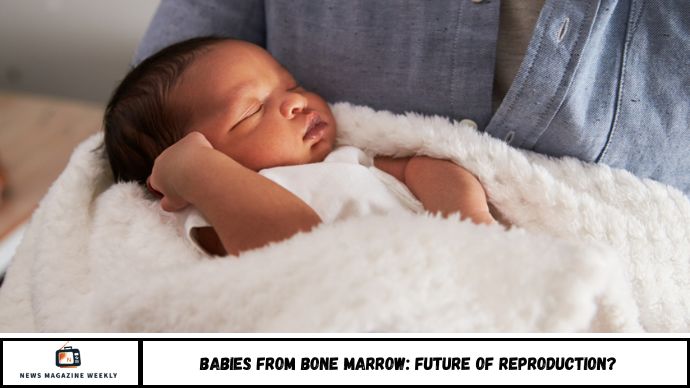Babies from Bone Marrow: Could This Be the Future of Human Reproduction?
The idea of creating babies from bone marrow-derived cells might sound like science fiction, but emerging research suggests it’s edging closer to reality. Scientists are exploring how stem cells from bone marrow could be transformed into egg cells, offering a potential path to reproduction without sperm or eggs from traditional donors. In this article, we’ll explore the science, current breakthroughs, challenges, and ethical questions surrounding this cutting-edge research.
In a groundbreaking experiment, microbiologist Karim Nayernia and his team at the North East England Stem Cell Institute may have taken a major step toward transforming the future of human reproduction. Using stem cells extracted from men’s bone marrow, they managed to turn these cells into immature sperm—by exposing them to a chemical environment that mimics the inside of the testes.
This marks the first time human non-reproductive tissue has been converted into gametes, a milestone with profound implications. If scientists can successfully mature these cells into fully functional sperm, it could offer new hope to men who are infertile or lack testes altogether—potentially allowing them to father biological children using their own genetic material.
Can Humans Be Created from Bone Marrow Cells?
Imagine a future where a person could conceive a child without needing eggs or sperm from another human. This is the ambitious goal behind research into creating gametes (egg or sperm cells) from bone marrow stem cells.
While this process is still in early stages and hasn’t been tested in humans yet, the possibility has already sparked widespread debate and scientific curiosity.
The Scientific Breakthroughs So Far
1. Stem Cells: The Starting Point
Bone marrow contains mesenchymal stem cells—a type of cell capable of transforming into other types of cells, including:
- Nerve cells
- Muscle cells
- Fat cells
- Potentially even reproductive cells
These versatile cells are at the core of the research.
2. Creating Egg Cells from Bone Marrow
In a 2007 study, researchers in the UK attempted to generate egg-like cells from bone marrow stem cells taken from women. While initial results showed promise, the research has yet to result in a fully functional egg capable of fertilization and embryo development.
What’s possible so far:
- Producing immature egg-like cells
- Encouraging early-stage ovarian development in lab conditions
- Inducing meiosis (the division process that creates sex cells)
3. Animal Research Shows Potential
In mice, scientists have been more successful:
- Embryonic stem cells and induced pluripotent stem cells (iPSCs) have been turned into viable eggs
- These eggs were fertilized and developed into healthy offspring
- Similar approaches are being explored for humans, but with significant biological and ethical barriers
Why This Matters: Medical and Social Implications
If successful, this breakthrough could transform fertility treatment by:
- Helping women with infertility due to age, illness, or early menopause
- Enabling same-sex female couples to have biologically related children
- Offering new hope for people who have lost fertility due to cancer treatments
However, it also raises complex questions about reproduction, genetics, and bioethics.
The Ethical and Biological Challenges
While the science is progressing, several major hurdles remain:
Biological Barriers
- Creating fully functional eggs from bone marrow is not yet proven in humans
- There’s a high risk of genetic instability or abnormal embryo development
- Long-term health impacts of lab-created gametes are unknown
Ethical Dilemmas
- Could this lead to “designer babies” or misuse of genetic engineering?
- What are the rights and responsibilities around lab-created life?
- Would this redefine the traditional roles in reproduction?
Experts urge caution, emphasizing the need for global bioethical standards before any human trials move forward.
FAQs
1. Can humans currently have babies from bone marrow cells?
No. The process is still experimental and hasn’t yet been successful in humans.
2. Has this worked in animals?
Yes. Scientists have successfully created viable eggs from stem cells in mice, resulting in live births.
3. Why use bone marrow to create eggs?
Bone marrow is rich in stem cells that can potentially be reprogrammed into egg cells, offering hope for fertility solutions.
4. Could this help same-sex couples have biological children?
Potentially. If eggs can be made from one partner’s stem cells, it may allow for new forms of reproduction.
5. What are the risks of this technology?
Risks include genetic abnormalities, ethical misuse, and untested long-term effects on offspring.
6. When could this be available to the public?
Widespread use is likely decades away, pending major scientific and ethical milestones.
Conclusion
Creating babies from bone marrow is not yet a reality—but it’s a fast-developing field with potential to reshape fertility science. Whether for medical necessity or future reproductive freedom, the ability to generate life from stem cells opens doors once thought impossible.
Yet with great possibility comes great responsibility. As researchers continue exploring this frontier, the world must balance scientific advancement with ethical oversight to ensure safe, thoughtful progress.

